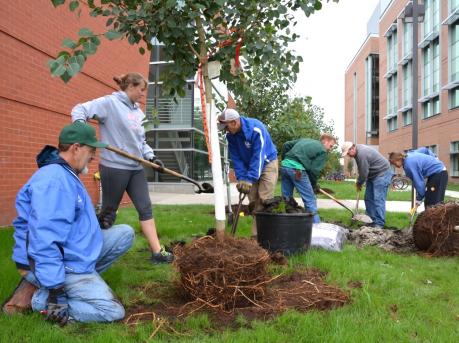If you want to celebrate Arbor Day by planting a tree, ISU Extension and Outreach is offering instructions Selecting the right tree helps ensure it will be a long-lived addition to your landscape. Planting trees requires specific steps and aftercare to ensure a successful outcome. In this article, Iowa State University Extension and Outreach horticulturists answer your questions about selecting and planting a tree on Arbor Day or any day this spring.
How do I select the best tree for my yard?
Properly selected trees have longer life spans and require less maintenance. Start by evaluating the growing conditions in the landscape. Most trees will need full sun to grow their best. Some species, like hackberry, will tolerate hot, intense late-day sun. Others, like redbud, will tolerate part-shade locations well. Check cold hardiness to be sure it will survive an average Iowa winter. Most trees prefer well-drained soils. However, several trees, like baldcypress and river birch, will grow quite well on chronically wet sites.
The best tree also fits the site’s needs. The growth habit and mature size of the tree needs to fit the planting location. This can prevent overcrowding, interference with overhead utility wires, obstruction of vehicular and pedestrian traffic, and other problems. Consider the tree’s resistance to common insect pests or diseases. Select species or cultivars that are resistant to common problems to reduce the likelihood of health issues later on. Finally, consider the tree’s ornamental features like flowers, bark color and texture, and fall color.
How do I select a high-quality tree for my yard?
Select high-quality nursery stock to increase the chances that your tree will thrive. Vigorous trees will have a healthy foliage color and a full, lustrous appearance. Look for trees that are evenly branched on all sides. At least two-thirds of the total height of the tree should have branches. Avoid trees with broken or rubbing branches, as well as those that have poor branching structure, such as double-leaders. A healthy trunk should be straight with no signs of injury.
Look for trees with healthy growth from year to year. Check last year’s growth by looking for the bud scale scars (scars that encircle the twig). From the tip of the twig to the bud scale scar indicates the amount the tree grew last year. Small amounts of growth (less than 4 inches) is sometimes an indication the tree is under stress.
Finally, evaluate the root system. Avoid trees that appear too large for their container, as they could be root-bound. Root-bound trees often have circling roots, which can girdle a tree if left uncorrected. Examine the plant’s root system by carefully removing the pot. Healthy roots are firm and lighter in color than the surrounding soil.What is the proper way to plant a container-grown tree?
Start by locating the trunk flare of the tree. This is the spot on the trunk that broadens just above the major roots of the tree. It is common for trees to be planted too deep in containers. Remove any soil off the top of the root ball to expose the trunk flare if needed.
Dig a hole two to three times wider than the diameter of the container. The depth of the hole should be the height of the root ball (after the extra soil has been removed to reveal the trunk flare). Slope the sides of the hole so the top of the hole is several inches wider than the bottom. In poorly drained soils, the depth of the hole should be approximately two-thirds of the height of the soil ball.
Once the hole has been prepared, carefully lay the tree on its side. Tap the sides of the container to loosen the soil ball from the container, then slide the tree out of its container. If the sides of the soil ball are a mass of roots, carefully shave off the outer ½ to 1 inch of the soil ball with a sharp spade or saw. Place the tree in the hole, checking to ensure the trunk flare is at the same level as the surrounding soil.
Gradually fill the hole with the same soil that was dug from the hole. Firm each new addition of soil in place with your hands. When finished, the backfill soil should match the surrounding grade. When planting in poorly drained soils, the backfill soil should gradually slope down to the surrounding site soil. Once planted, water thoroughly.
How do I care for a newly planted tree?
The most important thing you can do to have success with your new tree is to provide consistent and proper care during the establishment period, which for most container-grown trees is one to three years.
Regular and consistent watering is essential for newly planted trees. The roots of newly planted trees are initially confined to the plant’s root ball. Check the moisture status of the plant’s root ball and the surrounding soil regularly. Water when the soil begins to dry out by slowly applying water to the root ball and surrounding soil. Newly planted trees often need water every day for the first four or five days after planting, as the root ball can dry out quickly. Gradually reduce the watering frequency over the next two to three weeks to every seven to 14 days as roots begin to grow into the surrounding soil. Regularly check soil moisture all summer and into fall, applying water when soil conditions are dry.
To help conserve soil moisture, place 2 to 4 inches of mulch, such as wood chips or shredded bark, around trees. Typically, mulched areas are circular and extend outward from the trunk as wide as the branch spread or canopy. Mulches also help control weeds, moderate soil temperatures, and reduce the risk of mechanical damage to tree trunks from errant lawnmowers and string trimmers.
Do not severely prune the branches of newly planted trees. Pruning and the subsequent removal of foliage reduces the tree’s ability to manufacture food and slows plant growth. Additionally, it is generally not necessary to fertilize newly planted trees. Most Iowa soils supply sufficient nutrients during establishment.
Staking is not required for most newly planted trees. However, large trees and those planted in windy, exposed sites may require staking. If staking is necessary, stabilizing materials and techniques should allow the trunk to move or sway for proper trunk and root development. To prevent damage to the trunk, use strong, wide strips of canvas, rubber or other materials to support the tree. Remove the stakes as soon as possible. In most cases, stakes should be removed after one growing season.
































